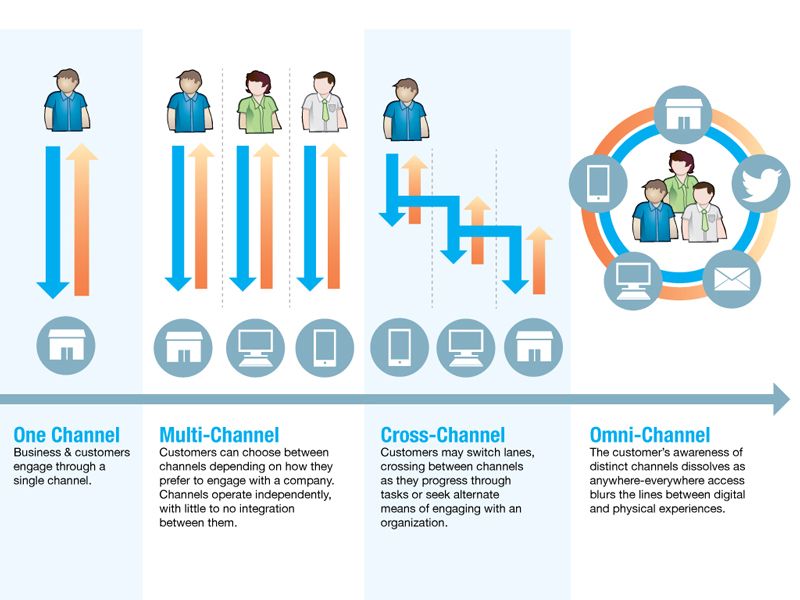Beyond Multichannel
Dennis Kardys Head of Design & Development#Digital Marketing, #CMS, #Design, #Design Advice

Your customer's form an impression of your brand based on their experiences across channels. With increasing expectations for anywhere anytime access to your products, services and support, I hope you're doing better than my post office!
A Story About My Mailbox
My family and I live in the city, in a four flat apartment building. A key broke off in building’s main mailbox lock, so for the last week the mail man’s just been lobbing a mail wad over our gate. All of the mail from each of our units is all mixed up! I wasn’t sure how things work: could I just call a locksmith? Or would the USPS be in charge of repairing it? Seemed like the post office would handle repairs to the main lock, but then why leave a post-it on the mail wad instructing us to get it fixed? I decided I’d call the post office and see what to do. Should be simple, right?
Am I an idiot? (That’s rhetorical!)
I’m a seasoned Web user, yet I struggled to find the number for the neighborhood post office on the USPS site. I tried dialing a number for the main Chicago branch, but it had been disconnected. Giving up on the USPS site, I tracked down an 800 number through Google. Finally, a real person to talk to! I was quickly informed that (surprise!) I’d need to talk to my local branch. The customer service rep couldn’t transfer me over, so I scribbled the number down as she read it off to me. I dialed it and it just rang and rang. I redialed and a fax line picked up. I dialed it again. I dialed it seven more times. Maybe the line was busy and it was just kicking over to the fax? Maybe I misdialed? Maybe I am an idiot! Eventually on Yelp, next to a 2-star review, I found the correct number to the local branch, who in turn referred me to call their maintenance and support number. Well I have great news everybody: In a week, or two...or maybe three, the mailbox will be fixed. Yay! Mission accomplished, kind of.
Are fragmented experiences the norm?
There were no terrible consequences to the runaround I got. But the pattern of my behavior was pretty typical to the behavioral patterns we observe in user experience research. People begin a task with the expectation that completing it should be easy. Frustration increases when friction is encountered along the way. When things don’t go right; when people hit a wall in the path to completing their task, they often blame themselves. Well, at least in the moment they do.
When recounting fragmented experiences, any negative sentiments can get projected back onto brand—and rightfully so.
Nobody wants to be left feeling frustrated or foolish when trying to engage with companies products and services. This is more important than ever, as today’s connected and empowered consumers can so readily elevate or cripple your brand.
Disjointed touchpoints abound
The USPS escapade, though comical, is a perfect example of how easily a disjointed customer experience can derail customers and tarnish a brand. In my attempt to get my mailbox lock fixed, I encountered a chaotic array of touchpoints:
- The mail man who left me the post-it note
- The website that I had trouble using to get what should have been easily accessible information
- The customer service person who referred me to the wrong number
- Google search engine results
- Post office information posted on Yelp
- Another customer service person who finally pointed me to the person that was equipped to help me
- The person that could actually help me
Be Convenient, Be Consistent
I was dealing with a single organization, yet each interaction happened in isolation. There was no degree of connectivity across them, which reveals big gaps in the service experience. This type of fragmentation between channels, touchpoints and platforms is common. Perhaps some come immediately to your mind. Have you ever been on a call and rolled your eyes after a human person asks you for the exact same information you had slowly and loudly just enunciated to an automated robotic voice IVR? “If this is correct, please say...Yes”.
We live our lives split between digital and physical experiences. As customers, and as users, we expect to be able to interact with companies anytime and anywhere. We expect to get timely customer service, over the phone, on a Website, or through social media. We expect information to be delivered to our door step.
And most of all, when we want to do that one thing—that thing where as customers we agree to accept a company’s call to action, where we say, “Yes, I would like to use your service, or buy your product, or enroll in your program, or get some help using the tool you provide,”—we want it to be easy, and we want it to be convenient. From a customer perspective that is the most basic expectation. From an organizational standpoint, it’s much harder. Standard organizational structures break companies into departmental silos: marketing, design, IT, online, customer service, etc. This breeds scenarios where products and services evolve in isolation within a channel. People can choose a number of ways to engage with you, but none of those channels work in concert with one another.

Moving Beyond Multi-channel
Multi-channel is not the ideal place to be, but it’s a natural progression. If you want to deliver a holistic brand experience that transcends channels, you first must exist in multiple channels, right? Where many companies seem to get hung up is in moving from multiple channels that operate independently (multi-channel) to a system that allows for customers to weave in and out of different channels effortlessly and almost unknowingly (omni-channel).
So what’s holding companies back? Moving beyond multi-channel requires a degree of technical sophistication; more specifically, the ability to manage and share data between channels, integrating with print publications, Web properties, product inventories and customer records. The other requirement is organizational maturity. You need the infrastructure to contribute to and manage service across channels, but you also need a culture that embraces the cross-pollination of ideas, building bridges between departments or breaking down the walls between operational silos.
Delivering great omnichannel experiences and providing great customer service that spans channels is an ambitious but attainable goal. It’s key to creating happy and loyal customers that advocate for your brand.
Related Posts

Diagram Partners with ai12z to Enhance Digital Transformation Solutions
Learn about Diagram and ai12z's partnership, enhancing digital experiences with AI-driven solutions for improved customer engagement.

2024 Umbraco US Festival Recap
Umbraco US Festival 2024 recap: a dynamic event on content management and digital experience trends and innovations.
Results Matter.
We design creative digital solutions that grow your business, strengthen your brand and engage your audience. Our team blends creativity with insights, analytics and technology to deliver beauty, function, accessibility and most of all, ROI. Do you have a project you want to discuss?
Like what you read?
Subscribe to our blog "Diagram Views" for the latest trends in web design, inbound marketing and mobile strategy.
